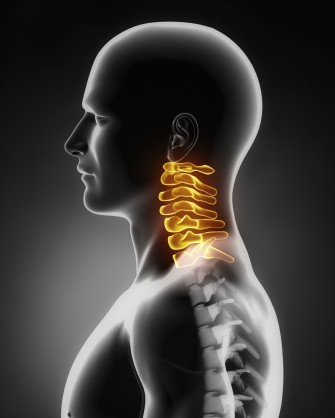Neck Pain and Chiropractic: A Non-drug approach to relief
 The cervical spine is made up of seven small vertebrae at the back of the neck between the top of the spine and the base of the skull. We can move our heads in nearly every direction because of the flexibility of the cervical spine. This flexibility, however, also makes the neck more susceptible to pain and injury.
The cervical spine is made up of seven small vertebrae at the back of the neck between the top of the spine and the base of the skull. We can move our heads in nearly every direction because of the flexibility of the cervical spine. This flexibility, however, also makes the neck more susceptible to pain and injury.
Acute neck sprains or strains can cause bruising, swelling and severe pain. First aid for such injuries is typically RICE (rest, ice, compression and elevation). After the swelling goes down, conservative chiropractic treatment can help injuries heal. There is a multitude of activities that may contribute to neck injury. In addition to offering a drug-free treatment option, doctors of chiropractic (DCs) can identify risk factors and suggest ways to prevent neck pain before it starts:
DAILY LIFE: Poor posture, obesity and weak abdominal muscles often disrupt spinal balance, causing the neck to bend forward to compensate. Holding the head forward while watching TV, reading or working can cause neck pain, too. The neck is designed to hold a 12 lb. head erect. When the head is allowed to roll forward to one side or backwards for too long, neck muscles and ligaments get stressed, and neck pain that can extend into the upper back and arms is often the result.
Sometimes a pillow is the culprit. It may be too high, too flat or it may not support the head well. Sleeping on the stomach with the head bent or twisted can “kink” the neck. Many people also develop neck pain by resting the chin or forehead on an upright fist or arm while reading or watching TV.
THE OFFICE: A fundamental understanding of workplace ergonomics is helpful when it comes to neck pain. To avoid stressing the neck, keep your eyes level with the upper third of your computer monitor.
Neck pain can result from reading for long periods from materials placed to the right or left of the computer while typing. Shift materials from left to right to left, etc., at least every 10 to 15 minutes to minimize strain to the neck muscles. Making persistent movements to one side of the body or keeping the neck in constant rotation can irritate joints and soft tissues. Poor sitting habits, especially slumping, can also cause neck pain.
ACCIDENTS: Whiplash is the sudden forced movement of the head or neck in any direction and the resulting “rebound” in the opposite direction. This type of sudden motion causes muscles to tighten up, often resulting in pain and stiffness. Severe whiplash can also cause injury to the intervertebral joints, discs, ligaments, muscles and nerve roots.
FALLS, BLOWS TO THE HEAD: Trips and falls can injure the head and neck. If you do fall, use your arms and hands to keep your head from striking hard surfaces.
AGING: Degenerative disorders associated with aging can affect the spine. For example, osteoarthritis causes progressive cartilage deterioration. The body may form painful bone spurs. Spinal stenosis narrows small nerve passageways in the vertebrae, compressing and trapping nerve roots. Stenosis may cause neck, shoulder, and arm pain and numbness. And degenerative disc disease can reduce the elasticity and height of intervertebral discs throughout the spine, resulting in pain.
Chiropractic Treatment for Neck Pain
For neck pain, your doctor of chiropractic may order diagnostic tests. An X-ray can show narrowed disc space, fractures, bone spurs or arthritis. A computerized axial tomography scan (a CT or CAT scan) or a magnetic resonance imaging test (an MRI) can show bulging discs and herniations.
DCs are conservative care doctors. They utilize a drugfree approach to treatment. If your chiropractor diagnoses a condition outside of this conservative scope, such as a neck fracture or an indication of organic disease, he or she will refer you to the appropriate medical physician or specialist.
Neck Adjustments
A neck adjustment (also known as cervical manipulation) is a precise procedure applied to the joints of the neck, usually by hand. A neck adjustment works to improve the mobility of the spine and to restore range of motion. It can also increase movement of the adjoining muscles. Patients typically notice an improved ability to turn and tilt the head and a reduction of pain, soreness and stiffness.
In addition to cervical manipulation, a chiropractic treatment plan may include mobilization, massage or rehabilitative exercises.
Strengthening Exercises
Ask your DC for a simple exercise or two to strengthen your neck. You’ll be surprised to see how helpful a little exercise can be when it comes to avoiding or reducing future neck pain.
Click here to find a local doctor of chiropractic.